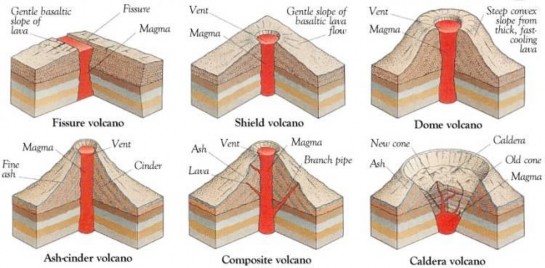3.4.1. Extrusive Landforms
Extrusive landforms are determined by the nature and composition of the lava. Major extrusive landforms are as under:
1. Cinder or ash cones are formed due to the accumulation of loose particles around the vent. Its size increases due to the continuous accumulation of volcanic material minus lava. The larger particles are arranged near the crater and the finer particles are deposited at the outer margins of the cone. The lava flows are so viscous that they solidify after a short distance.
2. Composite cones are the highest and are formed by the accumulation of various layers of volcanic material. They have alternate layers of lava and fragmented material, wherein lava acts as the cementing material. These are mainly associated with cooler and more viscous lava and the volcanoes associated with them are called composite volcanoes.
3. Shield Volcanoes are built almost entirely of fluid lava flows. They are named for their large size and low profile, resembling a warrior's shield lying on the ground. Barring the basalt flows, the shield volcanoes are the largest of all the volcanoes on the earth. These volcanoes are mostly made up of basalt, a type of lava that is very fluid when erupted. For this reason, these volcanoes are not steep.
4. Craters are depressions formed at the mouth of the volcanic vent, which is usually funnel- shaped. Some volcanoes may have greatly enlarged depressions called calderas. These are the result of violent eruptions accompanied by the subsidence of much of the volcano into the magma beneath. Water may collect in the crater or the caldera forming crater or caldera lakes.
5. Flood Basalt Provinces are formed when volcanoes outpour highly fluid lava that flows for long distances. Some parts of the world are covered by thousands of sq. km of thick basalt lava flows. There can be a series of flows with some flows attaining thickness of more than 50 m. Individual flows may extend for hundreds of km. The Deccan Traps from India, presently covering most of the Maharashtra plateau, are a much larger flood basalt province.

